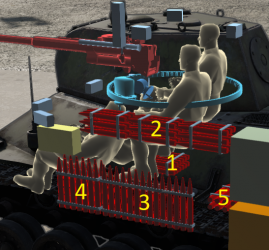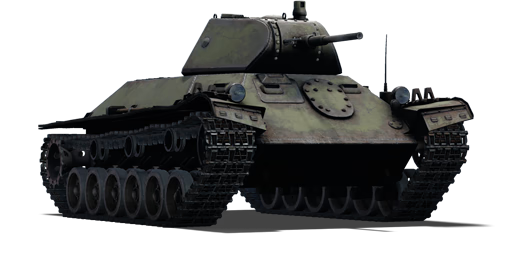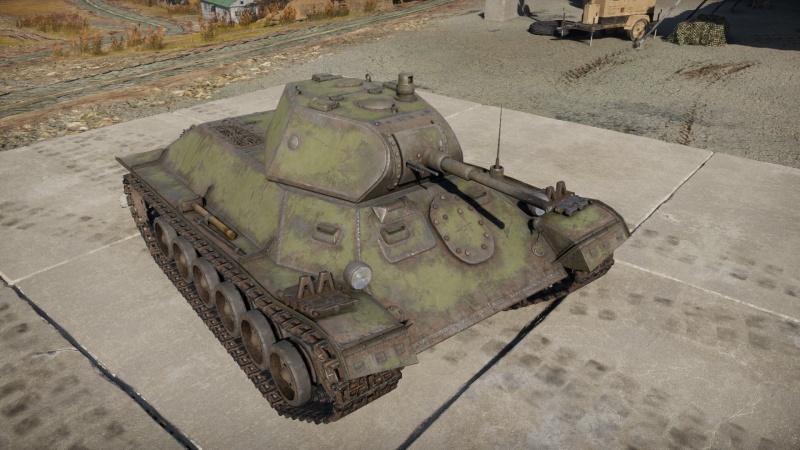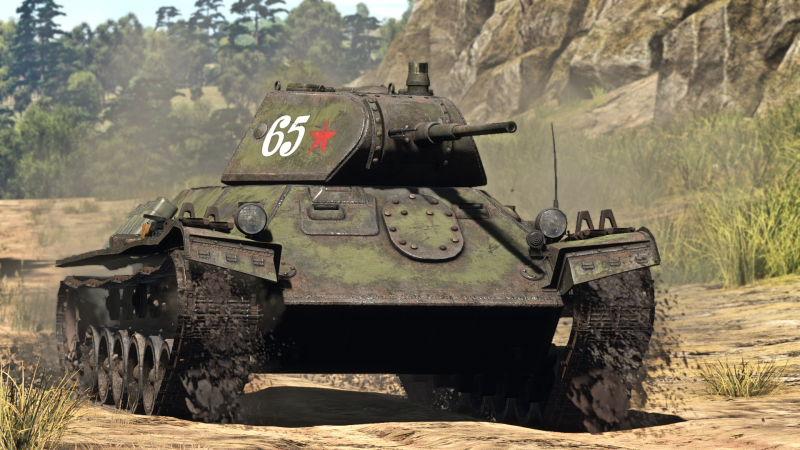Difference between revisions of "T-126"
m (Added a new Specs-Card thumbnail) |
(→In-game description: Reformatted) |
||
| Line 190: | Line 190: | ||
The tank would eventually be produced in 1941 during the German invasion in Operation Barbarossa. Only 69 T-50s were made before production ended in January 1942, the design suffered from being expensive, unreliable, and over-engineered. Today, two T-50 survive in intact condition, one normal variant in the Kubinka Tank Museum, and an up-armoured variant in Finland at a museum in Parola. | The tank would eventually be produced in 1941 during the German invasion in Operation Barbarossa. Only 69 T-50s were made before production ended in January 1942, the design suffered from being expensive, unreliable, and over-engineered. Today, two T-50 survive in intact condition, one normal variant in the Kubinka Tank Museum, and an up-armoured variant in Finland at a museum in Parola. | ||
| − | + | {{break}} | |
| + | {{Navigation-Start|{{Annotation|Archive of the in-game description|An archive of the historical description of the vehicle that was presented in-game prior to Update 1.55 'Royal Armour'}}}} | ||
| + | {{Navigation-First-Simple-Line}} | ||
The T-126 experimental light tank was built in the summer of 1940 at Leningrad Experimental Automobile Factory #185. The project was developed on the basis of combat experience in Spain with the goal of creating a tank suitable for the conditions of future wars. Only one model of the tank was ever built, and it was never used in combat. | The T-126 experimental light tank was built in the summer of 1940 at Leningrad Experimental Automobile Factory #185. The project was developed on the basis of combat experience in Spain with the goal of creating a tank suitable for the conditions of future wars. Only one model of the tank was ever built, and it was never used in combat. | ||
| + | {{Navigation-End}} | ||
== Media == | == Media == | ||
Revision as of 21:04, 20 October 2022
Contents
Description
The T-126(SP) is a premium rank II Soviet light tank with a battle rating of 3.0 (AB/RB/SB). It was introduced in Update 1.47 "Big Guns".
A premium version of the T-50, it shares it similarities due to being its prototype design, but actually is better due to much thicker all-around armour. An unfortunate side effect results in a decrease in top overall speed due to weight of added armour.
General info
Survivability and armour
Compared to the T-50, the T-126 can boast a better all-around armour for both the hull and turret. The only areas that the T-126 had same or weaker armour compared to the T-50 is the roof and the rear armour.
The front hull has the most impressive improvement, from a 40 mm plate on the T-50 to a 55 mm plate at the same sloping angle. This gives the T-126 a front armour protection similar to that of a medium tank, which is enough to shrug off most tank armament kinetic shells at a distance. The T-126 can even compound angle itself towards the enemy to present significant armour thickness on the front and side armour.
With the rather thick armour all-around the tank, a T-126 does not need to worry much about how they are presenting the tank towards the enemy when taking enemy fire. The only concerns would be shots directly perpendicular to the side armour, which can hit the ammo rack or crew.
The crew is tightly packed in the light tank, and so a penetrating shot through the front armour is most likely to knock out most, if not all, of the crew in a single shot. Shots to the side hull armour are also concerning as a large line of ammo racks line the port side of the hull, which means a clean penetration on either side of the hull can hit one of these racks and detonate the ammunition. The fuel and engine in the rear are also a concern, but are packed there isolated from the crew. They may also absorb any shells coming directly from the T-126's rear armour, protecting the crew. However, this will immobilise the T-126 and allow the enemy to flank for a side shot that will hit thez ammo rack of crew.
Armour type:
- Rolled homogeneous armour
| Armour | Front | Sides | Rear | Roof |
|---|---|---|---|---|
| Hull | 55 mm (53-54°) Front glacis 45 mm (53°) Cheeks 45 mm (44°) Lower glacis |
45 mm (38-41°) Top 45 mm Bottom |
30 mm (56°) Top 30 mm (5-42°) Bottom |
15 mm |
| Turret | 45 mm (6-72°) Turret front 40 mm (9-48°) Gun mantlet |
45 mm (24-27°) | 45 mm (24°) | 15 mm |
Notes
- Suspension wheels and tracks are 15 mm thick in armour.
Mobility
With the same 300 hp engine (572 hp in arcade) as the T-50, the T-126 has a significant difference in movement characteristics due to being about 5 tons heavier. Despite this, the T-126 is a rather quick vehicle. The forward acceleration is great and the T-126 can reach a sufficiently high forward speed quickly. Turning when moving can also be done in bursts for fast correction courses, but prolonged turning will drain the speed quickly.
The speed the T-126 is able to pick up makes it able to perform in a scout or flanking role on the battlefield.
| Game Mode | Max Speed (km/h) | Weight (tons) | Engine power (horsepower) | Power-to-weight ratio (hp/ton) | |||
|---|---|---|---|---|---|---|---|
| Forward | Reverse | Stock | Upgraded | Stock | Upgraded | ||
| Arcade | 40 | 6 | 18.3 | 465 | 572 | 25.41 | 31.26 |
| Realistic | 36 | 5 | 265 | 300 | 14.48 | 16.39 | |
Modifications and economy
Armaments
Main armament
The 45 mm 20-K cannon is familiar to those researching the Soviet tech tree, making up the main armament of the reserve tanks BT-5 and T-26. However, at rank II, the 45 mm starts to feel lacking at a distance against the even medium tanks. This is made up with the availability of APCR rounds for the cannon, but this is only useful at targets less than 1 kilometres due to the faster penetration drop-off and also on flat armour due to the poor slope attack characteristics of APCR.
| 45 mm 20-K | Turret rotation speed (°/s) | Reloading rate (seconds) | |||||||||||
|---|---|---|---|---|---|---|---|---|---|---|---|---|---|
| Mode | Capacity | Vertical | Horizontal | Stabilizer | Stock | Upgraded | Full | Expert | Aced | Stock | Full | Expert | Aced |
| Arcade | 150 | -8°/+25° | ±180° | N/A | 7.62 | 10.54 | 12.80 | 14.16 | 15.06 | 3.77 | 3.34 | 3.07 | 2.90 |
| Realistic | 4.76 | 5.60 | 6.80 | 7.52 | 8.00 | ||||||||
Ammunition
| Penetration statistics | |||||||
|---|---|---|---|---|---|---|---|
| Ammunition | Type of warhead |
Penetration @ 0° Angle of Attack (mm) | |||||
| 10 m | 100 m | 500 m | 1,000 m | 1,500 m | 2,000 m | ||
| BR-240 | APHEBC | 70 | 67 | 58 | 47 | 39 | 32 |
| BR-240SP | AP | 73 | 70 | 60 | 50 | 41 | 34 |
| BR-240P | APCR | 106 | 98 | 72 | 48 | 33 | 22 |
| Shell details | |||||||||
|---|---|---|---|---|---|---|---|---|---|
| Ammunition | Type of warhead |
Velocity (m/s) |
Projectile Mass (kg) |
Fuse delay (m) |
Fuse sensitivity (mm) |
Explosive Mass (TNT equivalent) (g) |
Ricochet | ||
| 0% | 50% | 100% | |||||||
| BR-240 | APHEBC | 760 | 1.43 | 1.2 | 9 | 29.26 | 48° | 63° | 71° |
| BR-240SP | AP | 757 | 1.43 | N/A | N/A | N/A | 47° | 60° | 65° |
| BR-240P | APCR | 1,070 | 0.85 | N/A | N/A | N/A | 66° | 70° | 72° |
Ammo racks

| Full ammo |
1st rack empty |
2nd rack empty |
3rd rack empty |
4th rack empty |
5th rack empty |
Visual discrepancy |
|---|---|---|---|---|---|---|
| 150 | 121 (+29) | 91 (+59) | 61 (+89) | 31 (+119) | 1 (+149) | Yes |
Machine guns
| 7.62 mm DT | ||||
|---|---|---|---|---|
| Mount | Capacity (Belt) | Fire rate | Vertical | Horizontal |
| Coaxial | 1,890 (63) | 600 | N/A | N/A |
Usage in battles
Being the prototype of the T-50, the T-126 plays very similarly to it. Some major performance differences come in the T-126's construction compared to the T-50. The T-126, despite being almost 5 tons heavier than the T-50, still moves at a serviceable speed for most light tank operations. This weight difference is due to the T-126 armour being somewhat thicker at the front and sides, giving the T-126 more protection compared to the T-50 and so it translates to better protection against most small-calibre enemy projectiles. The two tanks do share a very slow turret traverse rate, slow enough that it is faster to turn the hull towards the enemy than the turret.
As such, the T-126 excels in an open map with sufficient cover when advancing, such as Karelia or Ash River. Players should make the most of the T-126's speed to advance towards the point. Use the T-126's front armour, which can get to more than 70 mm of effective thickness when facing head-on, to bum rush through any encountered enemies. When making a mad dash to the point, the most common enemy tank type met are other light tanks, which at this battle rating tend to have light-calibre guns ranging from 37 mm to 50 mm. Against these guns, the T-126 stands a good chance at resisting the enemy projectile so long as the T-126 player prevents them from obtaining a good shot. Once a point is captured, one should focus on advancing towards the next point rather than stick around and defend the point. Unfortunately, while the 45 mm gun is still sufficient for close-range attacks, it is rather poor at longer ranges and against heavier armoured vehicles, even medium tanks. This, combined with the T-126's slow turret traverse rate, means it is poor in the defense where it has to react to an enemy offensive that is at liberty to approach the captured point from any direction.
Terrain where the T-126 would be rather poor at is on extreme open area with no cover available and in city maps. Open area are a concern due to the presence of tank destroyers that could quite easily pierce through the T-126's armour. With the 45 mm inability to have a threatening punch from a long range away, the tank destroyers could plink at the T-126 with ease. City maps are also a concern due to the poor turret traverse rate of the T-126. Encountering an enemy around the street corner could be difficult and time-consuming if the turret must be angled correctly to get a good shot off, especially if the space does not permit the freedom to use the hull to turn the turret towards the enemy. While the T-126 could still perform on both of these terrains, extra care should be used by the T-126 player to ensure it does not get outmatched and destroyed.
Tanks of concern are in general medium tanks and tank destroyers as by this battle rating, the typical guns encountered are now at or greater than 75 mm while also being at a high-enough velocity to punch through the T-126's armour. As such, when moving between points, be wary of zones where enemy would hide and ambush the T-126 as it drives by. Medium tanks with sloped armour will be of big concern if encountered from the front, and so attempts must be made to attack the side armour either by ambush or by outmanoeuvring the tank.
Some concerning vehicles to keep an eye for:
- M4 Shermans: Their sloped frontal armour leaves little frontal weakpoints available to the T-126's 45 mm cannon, while the M4's 75 mm can cleave through the T-126 with relative ease. Most of these M4 also have a sufficiently high turret traverse rate that it could respond to the T-126's attempt to outflank it if spotted. The one M4 variant that is easier to deal with is the M4A3 (105) version, which has a slower traverse rate and a longer reload time compared to the 75 mm variants. The 105 mm shells also have a lower muzzle velocity, meaning the M4A3 (105) is less likely to engage a moving T-126 at a farther distance.
- M10 GMC: Despite being a lesser-armoured and slower-traversing version of the M4, the gun is upped to a 76 mm that can more than easily cut through the T-126's armour. The front armour is slightly easier to penetrate from the front, but only in relatively short ranges. The slower turret traverse rate could be exploited by attacking the M10 from an angle it is not facing.
- M24: Compared to other light tanks, the M24 is equipped with the same 75 mm as the M4 Sherman tanks. As such, the M24 can be troublesome if when rushing a capture point since while the T-126's armour can shrug off other light tank guns, the M24's 75 mm can be quite lethal with a good hit. That said, if the T-126 could manage a shot off at the M24 before the latter could fire, then it could become a non-issue.
- Pz.IVs: The Pz.IV's long gun is of big concern as these guns can very easily cut through the T-126's armour without issue. The fast muzzle velocity also means the Pz.IV is more inclined to take out the T-126 from a distance before the T-126 could get close enough to be able to effectively damage it. The one caveat the Pz.IV has is the rather boxy armour construction, which means there is little sloping effect involved in preventing the 45 mm from penetrating. As such, it is easier to find the Pz.IV head-on and aim at a perpendicular angle right in the front hull armour and penetrate with the 45 mm cannon. A hit in the front would immobilize the Pz.IV and can allow for a flanking manoeuvre to hit the enemy tank from the sides directly to the crew compartment.
- Sd.Kfz.234/2: As Germany's premier light tank at the battle rating, the 234/2 "Puma" is extremely fast and can usually beat the T-126 at a race to the capture point. Armed with a 50 mm cannon, the 234/2 can also penetrate the T-126's armour and so they are a cause of concern for T-126 players.
Pros and cons
Pros:
- Up-armoured angled front plate gives good protection
- Serviceable cannon at its rank
- Angled armour all around upper hull
- Decent mobility
Cons:
- Slow turret rotation
- Gun mantlet is a significant weak spot
- Struggles in an up-tiered battle
- Cheeks on the corner of the frontal armour, which results in massive weakspots if you are not facing enemies
- Limited gun depression
- 4-man crew extremely tightly packed - a penetrating APHE can easily knock out all 4
History
Development
The Spanish Civil War gave the Soviets insight on the future of tank warfare, and the knowledge led to an attempt to upgrade or replace their tank forces that consisted mainly of the T-26 light tanks. The development started in 1939 to create a replacement with for the T-26 and BT light tanks.
The project for the new tank began as the SP project, which is short for Soprovzhdeniya Pekhoty, which means "Infantry Support". The project was headed by the OKMO tank design bureau at the S.M. Kirov Factory No. 185 in Leningrad under the individuals L. Troyanov and I. Bushnevov. Two prototypes, the T-126 and the T-127 was built, and the T-126 was to be further developed into the finished design. The finished design would become the T-50 light tank, which was an intricate light tank for the Soviets at the time. The tank featured sloping armour, torsion bar suspension, diesel engine, three-man turret, and a commander's cupola, all of which were advanced features at the time.
Production
The tank would eventually be produced in 1941 during the German invasion in Operation Barbarossa. Only 69 T-50s were made before production ended in January 1942, the design suffered from being expensive, unreliable, and over-engineered. Today, two T-50 survive in intact condition, one normal variant in the Kubinka Tank Museum, and an up-armoured variant in Finland at a museum in Parola.
| Archive of the in-game description | |
|---|---|
|
The T-126 experimental light tank was built in the summer of 1940 at Leningrad Experimental Automobile Factory #185. The project was developed on the basis of combat experience in Spain with the goal of creating a tank suitable for the conditions of future wars. Only one model of the tank was ever built, and it was never used in combat. | |
Media
- Skins
- Videos
See also
- T-50 - Production version of the T-126.
External links
- [Tanks-encyclopedia] T-50 light tank (the production model of T-126)
- [Military Factory] T-50- Light Infantry Tank (1941)
- [www.Tank-Hunter.com] Surviving Soviet WW2 Tanks - The T-50 Light Tank (with one image of the T-126).
| Experimental Design and Mechanical Engineering Department | |
|---|---|
| Light Tanks | |
| T-26 | T-26 · T-26 (1st Gv.T.Br.) · T-26E · T-26-4 |
| T-50 | T-50 · T-126 |
| Heavy Tanks | T-35 |
| Tank Destroyers | SU-5-1 · SU-100Y |
| Export | |
| T-26 | ␗T-26 · T-26 No.531 |
| See Also | Omsk Transport Engineering Plant |
| USSR light tanks | |
|---|---|
| T-26 | T-26 · T-26 (1st Gv.T.Br.) · T-26-4 · T-26E |
| BT | BT-5 · RBT-5 · BT-7 · BT-7 TD · BT-7M · BT-7A (F-32) |
| T-50 | T-126 · T-50 |
| T-70 | T-70 · T-80 |
| PT-76 | PT-76B · PT-76-57 · Object 906 |
| BMP | BMP-1 · BMP-2 · BMP-2M · BMP-3 |
| BMD | BMD-4 |
| 2S25 | 2S25 · 2S25M |
| Wheeled | BA-11 · BTR-80A |
| Other | T-60 · Object 685 · 2S38 |
| China | ▂Type 62 |
| USSR premium ground vehicles | |
|---|---|
| Light tanks | BA-11 · RBT-5 · BT-7A (F-32) · T-26 (1st Gv.T.Br.) · T-26E · T-126 · PT-76-57 · 2S38 |
| Medium tanks | T-34 (Prototype) · T-34 (1st Gv.T.Br.) · T-34E · T-34-57 (1943) · T-34-85E · T-34-100 · T-44-122 · TO-55 · T-55AM-1 · T-72AV (TURMS-T) · T-80UD · Т-80U-Е1 |
| ▂M3 Medium · ▂M4A2 · ▂T-III · ▂T-V · ▂МК-IX "Valentine" | |
| Heavy tanks | SMK · T-35 · ▂MK-II "Matilda" · KV-1E · KV-2 (1940) · KV-2 (ZiS-6) · KV-122 · KV-220 · IS-2 "Revenge" · Object 248 · IS-6 · T-10A |
| Tank destroyers | BM-8-24 · BM-13N · BM-31-12 |
| SU-57 · SU-76D · SU-76M (5th Gv.Kav.Corps) · SU-85A · SU-100Y · SU-122P · Object 120 | |
| SPAA | ▂Phòng không T-34 · ZUT-37 |






